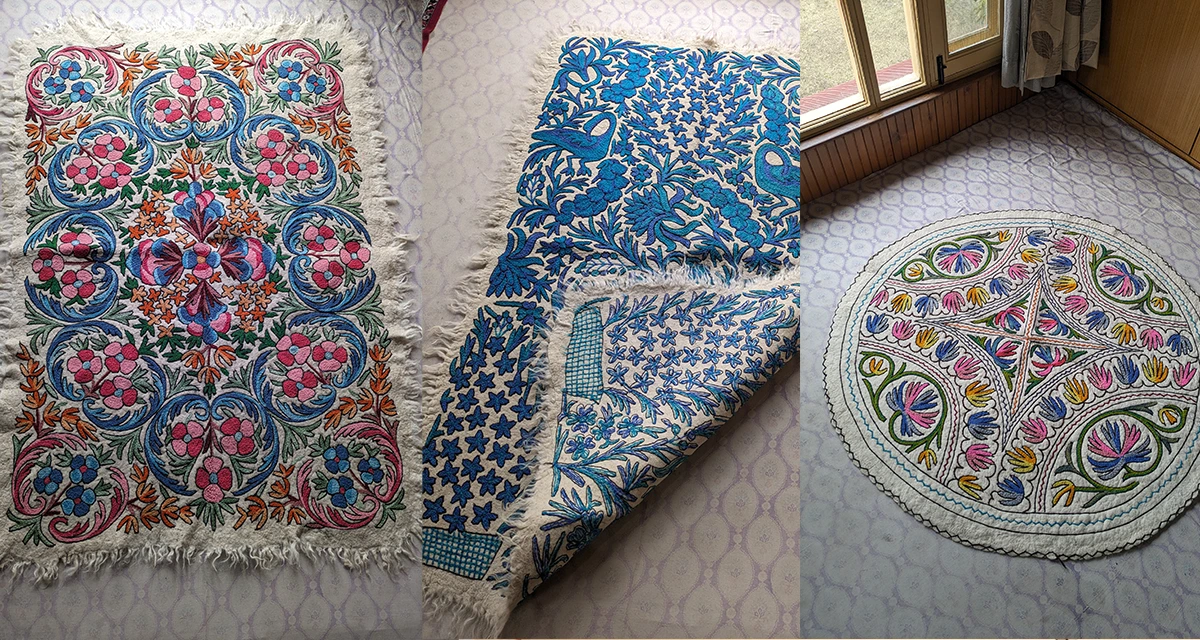Kashmiri Culture
The Rich Legacy of Kashmiri Namdas
Kashmiri Namdas, a traditional form of felted woolen rugs, have a rich and captivating history. The term “Namda” originates from the Persian word “Namadsazi,” while its roots can also be traced back to the Sanskrit word “Namtar.” This craft has been an integral part of Kashmiri culture for centuries, flourishing due to the region’s cold climate and abundant wool supply.
The Rise of Namda Craft in Kashmir
Namda-making was once one of the most profitable trades in Kashmir. The valley’s large population of sheep provided a steady supply of wool for artisans. This craft was not confined to Kashmir alone; later Namdas were also produced in Mazandaran (Iran) and Sindh (Pakistan). The trade thrived in Yarkand Sarai, Safakadal, a major commercial hub where these exquisite felted rugs were exchanged.
Certain localities in Kashmir became well-known for Namda-making, such as Bahuddin Mohalla, which came to be called Namda Saz Mohalla or Namdegar Mohalla. Initially, coverings for feet were made from wool, and artisans discovered that sweat caused the wool to stick together, leading to the idea of felting wool into rugs. At first, only men practiced this craft, but later, women also became involved.
Namda-making was a labor-intensive process. Streets in artisan neighborhoods were lined with Namdas, and large rooms were dedicated to the craft. Artisans would spread wool over special woven mats called “Waghu,” with different varieties of Waghu determining the quality and price of the Namda. The process began with wool carding, followed by layering it in three sections on the Waghu. A local soap was used in felting, along with tools called “Panja” and “Chedi.” The wool was then enclosed in a covering, tied with ropes, and subjected to a meticulous process of felting. This included stomping on the Namda with feet and compressing it with arms in a method known as “Mandayi.” Finally, the Namda was sent for intricate hand embroidery.
Namdas in the Global Market
Kashmiri Namdas gained international recognition during World War I in 1914 when foreign armies stationed in transit camps in Kashmir discovered these woolen rugs. Their warmth and durability made them highly desirable. Later, during World War II , British soldiers passing through Kashmir also took an interest in Namdas and purchased them, further popularizing the craft worldwide.
To meet growing demand, Namdas were even imported from Himachal Pradesh and Ladakh. The industry thrived, providing employment to numerous artisans and playing a vital role in Kashmir’s economy.
The Decline of the Namda Industry
Despite its glorious past, the Namda industry in Kashmir faced a steep decline in later years. A key factor was the increasing greed of some artisans, who started mixing cotton with wool to maximize profits. This compromise on quality led to a loss of interest among buyers, ultimately pushing the craft toward extinction.
Additionally, modernization, evolving consumer preferences, and inadequate government support further contributed to the industry’s downfall. Once-bustling markets filled with colorful Namdas gradually became empty as demand dwindled.
Revival Efforts and the Future of Kashmiri Namdas
In recent years, various efforts have been initiated to revive the Namda craft. Government programs and artisan cooperatives are working to restore the authenticity of Namdas by promoting the use of pure wool and traditional techniques. Handicraft organizations and NGOs are playing a crucial role in ensuring that artisans receive fair wages and recognition for their work.
Furthermore, online platforms and e-commerce have opened new opportunities for marketing these handcrafted rugs to a global audience. By leveraging digital platforms, artisans can reach customers beyond Kashmir, ensuring the sustainability of this centuries-old tradition.
Kashmiri Namdas are not just rugs; they are a testament to the region’s rich cultural heritage. Preserving this art form is vital to sustaining the livelihoods of skilled artisans and keeping an age-old tradition alive. With the right support and exposure, Namdas can once again reclaim their lost glory and find a cherished place in the global market.
Support Namda craft by purchasing a Gyawun Namda




